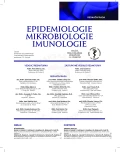Cat scratch disease – a neglected zoonosis
Authors:
L. Hozáková 1,2; L. Rožnovský 2; V. Janout 1
Authors‘ workplace:
Ústav epidemiologie a ochrany veřejného zdraví, Lékařská fakulta OU Ostrava
1; Klinika infekčního lékařství, FN Ostrava
2
Published in:
Epidemiol. Mikrobiol. Imunol. 66, 2017, č. 2, s. 99-104
Category:
Review Article
Overview
Cat scratch disease is a relatively rare infection that is caused by the bacterium Bartonella henselae. This disease occurs after cat scratch or bite. The course of the disease depends on the patient’s immunity status. In immunocompetent patients, the disease typically runs as a lymph node syndrome. Sometimes, mild general symptoms may appear, or the course can be atypical with a more serious clinical manifestation involving various organs. In immunocompromised patients, Bartonella henselae can cause bacillary angiomatosis or peliosis with a severe course.
KEYWORDS:
cat scratch disease – lymph node syndrome – atypical course – diagnosis – treatment
Sources
1. Černý Z. Infekce vyvolané bartonelami. In Beneš J. Infekční lékařství. 1. vyd. Praha: Galén; 2009. s. 301–303.
2. Sanago YO, Zeaiter Z, Caruso G. Bartonella henselae in Ixodes ricinus Ticks (Acari: Ixidida) removed from humans, Belluno province, Italy. Emerg Infect Dis, 2003;9(3):329–32.
3. Pennisi MG, Marsilio F, Hartmann K, Lloret A. Bartonella species infection in cats. ABCD guidelines on prevention and management. J Feline Med Surg, 2013;15(7):563–569.
4. Melter O. Novinky v problematice bartonelových infekcí. Klin Mikrobiol Infekc Lek, 2013;9(2):36–44.
5. Chomel BB, Kasten RW, Stuckey MJ. Experimental infection of cats with Afipia felis and various Bartonella species or subspecies. Vet Microbiol, 2014;172(3–4):505–510.
6. Maciás A, Aguirre C, Bustamante A, Garcés C, et al. Cat scratch disease in Colombia. Oxf Med Case Reports, 2014;1(3):43–45.
7. Slater LN, Welch DF. Bartonella, including Cat-Scratch Disease. In Mandell, Douglas, and Bennett. Principles and Practice of Infectious diseases. 6. edit. Philadelphia: Elsevier; 2005. s. 2733–2748.
8. Fleischman DA, Chomel BB, Burgos K. Impact of queen infetion on kotten susceptibility to different strains of Bartonella henselae. Vet Microbiol, 2015;180(3–4):268–272.
9. Melewska KM, Mania A, Kemnitz P, et al. Cat-scratch disease: a wide spectrum of clinical pictures. Postepy Dermatol Alergol, 2015;32(3):216–220.
10. Melter O, Hercík K, Weyant RS. Detection and characterization of feline Bartonella hensellae in the Czech Republic. Vet Microbiol, 2003;93(3):261–273.
11. Hercík K, Hásová V, Janecek J, Branny P. Molecular evidence of Bartonella DNA in ixodid ticks in Czechia. Folia Microbiol, 2007;52(5):503–509.
12. Brunetti E, Fabbi M, Ferraioli G, Prati P. Cat-scratch disease in Northern Italy: atypical clinical manifestations in humans and prevalence of Bartonella infection in cats. Eur J Clin Microbiol Infect Dis, 2013;32(4):531–534.
13. King KY, Hicks MJ, Mazziotti MV, Eldin KW. Persistent Cat Scratch Disease Requiring Surgical Excision in a Patient With MPGN. Pediatrics, 2015;135(6):e 1514-7.
14. High K, Van Meter J. An 8-year-old Boy with altered mental status. Air Med J, 2015;34(3):149–151.
15. Zenone T. Systemic Bartonella henselae Infection in Immuno-competent Adult Presenting as Fever of Unknown Origin. Case Rep Med, 2011;2011:183937.doi:10.1155/2011/183937.
16. Barson WJ, Honegger JR, Texter K. Acute myopericarsitis associated with cat scratch disease in an adolescent. Pediatr Infect Dis J, 2014;33(9):982–984.
17. Hozáková L, Rožnovský L, Franková H. Felinóza – stále aktuální zoonóza. Klin Mikrobiol Infekc Lek, 2014;20(1):4–10.
18. Shasha D, Gilon D, Vernea F, Moses AE, Strahilevitz J. Visceral Cat Scratch Disease with Endocarditis in an Immunocompetent Adult: A Case Report and Review of the Literature. Vector Borne Zoonotis Dis, 2014;14(3):175–181.
19. Lindeboom JA. Pediatric cervicofacial lymphadenitis caused by Bartonella henselae. Oral Surg Oral Med Oral Patho Oral Radiol, 2015;120(4):469–473.
20. Meier JD, Grimmer JF. Evaluation and Management of Neck Masses in Children. Am Fam Physician, 2014;89(5):353–358.
21. Pinto Jr VL, Curi AL. Cat scratch disease complicated with aseptic meningitis and neuroretinitis. Braz J Infect Dis, 2008;12(2):158–160.
22. Gradidge E, Chauhan A, Stelle RW, et al. Fever, lymphadenopathy, and splenomegaly: did the cat do it? Clin Pediatr (Phila), 2013;52(11):1072–1074.
23. García JC, Núňez MJ, Castro B, Fernández JM. Hepatosplenic Cat Scratch Disease in Immunocompetent Adults. Report of 3 Cases and Review of the Literature. Medicine (Baltimore), 2014;93(17):267–279.
24. Choi AH, Bolaris M, Nguyen DK, Panosyan EH. Clinicocytopathologic Correlation in an Atypical Presentation of Lymphadenopathy With Review of Literature. Am J clin Pathol, 2015;143(5):749–754.
25. Fouch B, Coventry S. A case of fatal dissemminated Bartonella henselae infection (Cat scratch disease) with encephalitis. Arch Pathol Lab Med, 2007;131(10):1591–1594.
26. Laswell EM, Chambers KD, Whitsl DR, Poudel K. New-Onset Refractory Epilepticus in an Adult with an Atypical Presentation of Cat-Scratch Disease: Successful Treatment with High-Dose Corticosteroids. Pharmacotherapy, 2015;35(6):e 106–110.
27. Nishio N, Kubota T. Cat scratch disease with encephalopathy in a 9-year-old girl. Pediatr Int, 2008;50(6):823–824.
28. Medková Z. Bartonelózy. Klin Mikrobiol Infekc Lek, 2004;10(5):207–213.
29. Palumbo E, Sodini F. Immune thrombocytopenic purpura as a complication of Bartonella henselae infection. Infez Med, 2008;16(2):99–102.
30. Kimura A, Hasegawa S, Yanagihara M, Inoue H. Cat-scratch disea-se with severe pleuritis in a 6-year-old girl. Pediatr Int, 2015;57(3):501–503.
31. Rozsypal H. Onemocnění kůže. In Rozypal H. AIDS – klinický obraz a léčba. Praha: Maxdorf; 1998, s. 111–114.
32. Safont M, Angelakis E, Richet H, Lepidi H. Bacterial Lymphadenitis at a Major Referral Hospital in France from 2008 to 2012. J Clin Microbiol, 2014;52(4):1161–1167.
33. Jabcuga CE, Jin L, Macon WR, Howard MT. Broadening the Morphologic Spectrum of Bartonela henselae Lymphadenitis. Analysis of 100 Molecularly Characterized Cases. Am J Surg Pathol, 2016;40(3):342–347.
34. Mirouse G, Journe A, Casabianca L, Moreau PE. Bartonella henselae osteoarthritis of the upper cervical spine in a 14-year-old boy. Orthop Traumatol Surg Res, 2015;101(4):519–522.
Labels
Hygiene and epidemiology Medical virology Clinical microbiologyArticle was published in
Epidemiology, Microbiology, Immunology

2017 Issue 2
Most read in this issue
- Diagnostic relevance of the chemokine CXCL13 and anti-C6 peptide antibodies in patients with neuroborreliosis
- Cat scratch disease – a neglected zoonosis
- The common bed bug (Cimex lectularius) – biology, medical relevance, possibilities for the detection and control
- Sepsis-related mortality in the Czech Republic: multiple causes of death analysis
